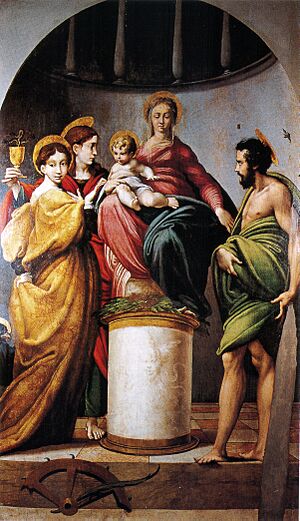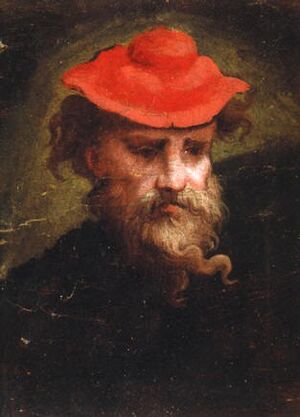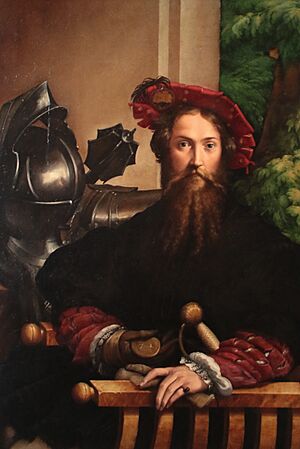Parmigianino facts for kids
Quick facts for kids
Parmigianino
|
|
|---|---|

Self-portrait in a Convex Mirror (c. 1524, age about 21), Kunsthistorisches Museum, Vienna
|
|
| Born |
Girolamo Francesco Maria Mazzola
11 January 1503 |
| Died | 24 August 1540 (aged 37) Casalmaggiore, Republic of Venice
|
| Nationality | Italian |
| Known for | Painting, etching |
|
Notable work
|
Self-portrait in a Convex Mirror Vision of Saint Jerome Madonna with the Long Neck |
| Movement | Mannerist |
Girolamo Francesco Maria Mazzola (born January 11, 1503 – died August 24, 1540) was an Italian painter. He is better known as Parmigianino, which means "the little one from Parma." He was a Mannerist artist, working in cities like Florence, Rome, Bologna, and his hometown of Parma.
Parmigianino's art style is known for being elegant and graceful. He often made figures with long, stretched-out shapes. Some of his most famous paintings include Vision of Saint Jerome (1527) and the unique Madonna with the Long Neck (1534). He is one of the most well-known artists from the early Mannerist period.
Parmigianino had an amazing and unique talent. However, his career faced challenges because of wars, especially the Sack of Rome in 1527. He died at just 37 years old. He made fantastic drawings and was one of the first Italian painters to try making prints himself.
His smaller paintings have always been popular and are now in major museums around the world. He also painted important portraits, helping to start a trend in Italy of showing people in three-quarter or full-length poses. This style was usually only used for kings and queens before.
Contents
Early Life and Art Training
Parmigianino was the eighth child of Filippo Mazzola and Donatella Abbati. His father died from the plague when Parmigianino was only two years old. His uncles, Michele and Pier Ilario, raised him and his siblings. Both uncles were artists, though not very famous.
In 1515, his uncle received a job to decorate a chapel in San Giovanni Evangelista. A young Parmigianino later finished this work. By the time he was eighteen, he had already completed the Bardi Altarpiece.
In 1521, Parmigianino went to Viadana to escape the wars happening between different armies. There, he painted two artworks using tempera paint. One showed Saint Francis for a church, and the other was the Mystical Marriage of Saint Catherine. He also worked in San Giovanni and met the famous artist Correggio.
Working in Rome
In 1524, Parmigianino traveled to Rome with five small paintings. He hoped to get support from Pope Clement VII of the Medici family. One of these paintings was his Self-portrait in a Convex Mirror.
People in Rome were very impressed with Parmigianino's work. Some even said he was like Raphael reborn. In 1526, Parmigianino and his uncle agreed to decorate the church of San Salvatore in Lauro. They planned to paint an altarpiece called the Vision of Saint Jerome. However, a year later, the Sack of Rome happened. This war event forced Parmigianino and many other artists to leave the city.
Life in Bologna and Return to Parma
After leaving Rome, Parmigianino lived in Bologna for almost three years. Around 1528, he painted Madonna and Child with Saints. Later that year, he created Madonna con la Rosa and Madonna with Saint Zachariah. By 1530, Parmigianino had returned to his hometown of Parma.
In 1531, Parmigianino received a job to paint two altarpieces for the church of Santa Maria della Steccata. The church group paid him in advance and promised him supplies. However, by 1535, the project was still not finished.
In 1534, it was decided that his painting Madonna dal collo lungo (the Madonna with the Long Neck) would be placed in a family chapel.
Parmigianino likely hoped to become the main artist for the church after Correggio. But in 1538, other artists were chosen to decorate the apse and choir of the Parma Cathedral.
It is thought that around this time, Parmigianino became very interested in alchemy. Alchemy was an early form of chemistry where people tried to turn ordinary metals into gold. Some scholars believe he was trying to find a new way to make his etchings. Because of his focus on these experiments, he didn't finish much work for the church. He was even put in prison for two months for not completing his contract. Another artist, Giulio Romano, took over the project but also left it.
Parmigianino died from a fever in Casalmaggiore on August 24, 1540. He was only 37 years old. He is buried in the church of the Servite Friars.
Some artists who were influenced by Parmigianino include his cousin Girolamo Mazzuoli, Pomponeo Amidano, Giacomo Bertoia, and Francesco Borgani.
Parmigianino's Artworks
Parmigianino was also one of the first Italian artists to create etchings. Etching is a printmaking technique where an image is carved into a metal plate using acid. This method allowed artists to create prints that looked like their spontaneous drawings. Parmigianino was a "master of elegant figure drawing," and this technique suited him well.
He also designed chiaroscuro woodcuts. Even though he didn't make a huge number of prints, he had a big impact on Italian printmaking. Some of his prints were made with another artist named Giovanni Jacopo Caraglio.
Key Paintings and Prints
- Baptism of Christ (about 1519) – Oil painting
- Bardi Altarpiece (1521) – Tempera painting
- Saint Barbara (1522) – Oil painting
- Self-portrait in a Convex Mirror (about 1524) – Oil painting
- Portrait of a Collector (about 1524) – Oil painting
- Portrait of Galeazzo Sanvitale (1524) – Oil painting
- Portrait of Lorenzo Cybo (1524) – Oil painting
- Myth of Diana and Acteon (about 1524) – Fresco painting
- The Holy Family with Angels (about 1524) – Oil painting
- Antea (about 1524–1527) – Oil painting
- Madonna and Child (1525) – Oil painting
- Vision of Saint Jerome (1526–1527) – Oil painting
- Conversion of Saint Paul (about 1527) – Oil painting
- Holy Family with the Infant Saint John the Baptist (about 1528) – Oil painting
- The Mystical Marriage of St Catherine (1529) – Oil painting
- Turkish Slave (Portrait of a Lady; about 1533) – Oil painting
- Cupid Making His Arch (about 1533–1535) – Oil painting
- Madonna with the Long Neck (1534–1540) – Oil painting
- Portrait of Pier Maria Rossi di San Secondo (about 1535–1539) – Oil painting
- Virgin and Child with Saint John the Baptist and Mary Magdalene (about 1535-1540) - Oil painting
- Portrait of Camilla Gonzaga and Her Three Sons (about 1539–1540) – Oil painting
See also
 In Spanish: Parmigianino para niños
In Spanish: Parmigianino para niños
- Self-portrait in a Convex Mirror (book)





